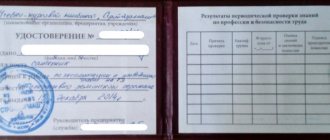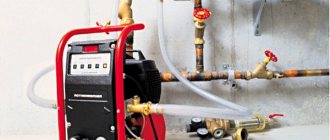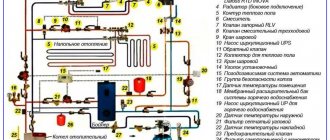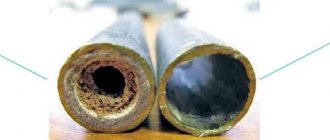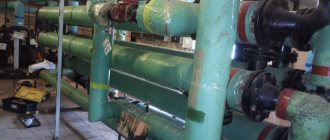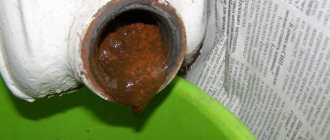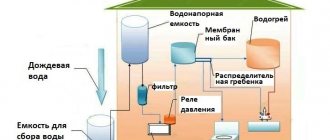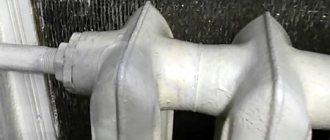Life in a private house surrounded by nature is impossible without a high-quality and reliable heating system. But an autonomous heating system in a private house is a complex engineering structure that requires regular technological maintenance. If such equipment is not given proper attention, it begins to become clogged. This is primarily due to the fact that process fluids used in heating system pipelines contain many additives. With a constant flow of water, they are deposited on the walls of pipes and the internal surfaces of various heating system devices. All this slows down the normal movement of the coolant, and broken areas of scale and sediment layers can clog the system or cause breakdowns of the circulating pumps. To prevent emergency situations, routine maintenance is carried out on the heating system, one of which is hydropneumatic flushing.
The process of hydropneumatic flushing of the heating system
SP-OM
The complex product of the SP-OM brand is used for flushing heating systems, heat exchangers, boilers and any other heat exchange equipment. Can be used in open and closed heat exchange circuits. "SP-OM" does not destroy aluminum and polymer elements of the system, as well as rubber gaskets. It has proven itself well on an industrial scale. There are various brands of SP-OM designed for specific operating conditions. Manufacturer's website - https://spomcom.ru/
SP-OM Pros
- effective removal of scale, rust and other deposits;
- wash-in-place;
- does not corrode rubber gaskets and seals;
- prevents corrosion of ferrous metals;
- may further include a corrosion inhibitor;
- Can be used with aluminum parts.
Minuses
Consultation and services of a flushing specialist may be required.
SP-OM
Metalin T is a product made on the basis of hydrochloric acid. Removes heavy lime deposits, rust products and organic matter in heating systems made of steel or non-ferrous metals. It is a non-flammable substance. After adding an alkaline neutralizer, the waste is allowed to be drained into the sewer. Packaged in concentrated form in containers from 1 to 30 liters.
Metalin T Pros
- non-flammable;
- quick cleansing.
Minuses
- after neutralization with alkali, discharge into the sewer system is allowed;
- not used for treating surfaces made of aluminum and its alloys.
Used in the treatment of pressure boilers, tubular heat exchange devices, boilers, condensers, pipelines in industry and domestic conditions. Removes various types of contaminants, in particular limestone and corrosive deposits. Ideal for washing plastic, metal and rubber pipes. Cleans carefully and does not have a negative effect on the structure of the seals. Not recommended for cleaning systems with surfaces made of aluminum and derivative alloys. Preliminary testing on treated stainless steel surfaces is also recommended.
4a293175f1908eda01bbc87f7b3a4bf3.jpe
SYNTILOR Watesup Pros
- does not affect the structure of metals;
- concentrated product;
- high efficiency even at low operating temperatures (20–35°C);
- does not damage seals and rubber gaskets;
- contains an inhibitor.
Minuses
cannot be used for products made of aluminum and derivative alloys.
Heating system cleaner SYNTILOR Watesup
Deoxyl-3
Deoxyl-3 is an acid-type product for chemical cleaning of pipelines in heating and water supply systems. It is packaged as a concentrate in 20 liter containers. The liquid is not flammable and belongs to toxicity class 3. For a greater cleaning effect, it is advisable to use the Deoxyl NO additive together with the drug. Foaming is neutralized by the Foral PG additive. The liquid is quite aggressive, so when working with it it is recommended to protect the skin and respiratory organs with protective equipment. Use strictly according to label instructions.
Deoxyl-3 Pros
- completely removes scale-corrosion deposits regardless of the design features of the equipment;
- biodegradable;
- after washing, the spent working solution can be drained into the sewer;
- The composition includes various inhibitors that prevent metal etching and the appearance of corrosion. Inhibitors not only remove deposits, but also protect the metal.
Minuses
The liquid is aggressive (work with it only with protective equipment).
Which system flushing products would you choose or would you recommend purchasing?
Deoxyl-3
75.00 % ( 3 )
Save your voting results so you don't forget!
To see the results you need to vote
Do-it-yourself heating flushing mechanically
For self-flushing radiators, mechanical cleaning technology is most applicable. In this case, you will not have to use any special equipment or specific chemicals.
Before you wash the heat exchanger of a gas boiler with your own hands, you should prepare the necessary materials:
- rags or old thick clothes. With their help, it will be possible to protect the bathtub from damage during the process of flushing the radiators in it;
- fum tape or plumbing linen with a tube of sealing paste;
- a pipe that allows you to connect a hose to threaded connections.
The equipment you will need is the following:
- two hoses;
- a set of keys;
- brush;
- steel wire brush;
- buckets, basin and rags.
The actual cleaning of the heat exchanger and lines consists of several stages.
- A hose of the appropriate diameter is connected to the drain pipe of the heating system. The other end of the hose is discharged into the sewer.
- A second hose is connected to the highest point of the system. As a rule, such a point is either a branch to the expansion tank or a safety group. The tank or safety group is unscrewed and a pipe is screwed into its place, onto which a hose is put. The second end of the hose is connected to the water supply.
- When everything is ready, water is supplied to the system. This makes it possible to get rid of scale and contaminants deposited in the system lines.
- Start draining the coolant. To do this, remove the hose through which tap water was supplied. The connection point to the system is not blocked. Under the influence of gravity, water begins to drain through the drain pipe at the lowest point of the line.
To completely drain the coolant, it is necessary to ensure that the outlet end of the hose is below the level of the heating system lines. In a private house, it will be possible to achieve such a configuration if you drain the water into buckets installed in the underground.
Radiators are removed from the dehydrated system
Care must be taken when doing this. It is likely that the threaded connections on them are coked and you will have to make some efforts, trying not to damage the threads. The removed radiators are transferred to a bathtub, previously covered with rags or thick fabric
Here they are washed with running water, treated with a brush and a steel wire brush. After flushing the radiator, it is carefully inspected again for any remaining contaminants. The radiators are installed in place.
df2185cefce037de2f4f59e24c82a23a.jpe
eea5416a8dab45beb5327b9907898e97.jpe
- The lines are filled with fresh water through the drain pipe. At the same time, monitor the formation of air pockets in the pipes and radiators. You can get rid of air bubbles by slightly opening the Mayevsky valves on the radiators. As soon as the air stops hissing and water begins to ooze from the tap, close it. As the lines fill, it is advisable to repeat this procedure several times.
- After the actual washing of the gas boiler heat exchanger is completed with your own hands, the heating system is put into operation.
- As the coolant begins to circulate, air pockets in the radiators may re-form. To eliminate them, the Mayevsky cranes are manipulated again. Some of the air will be removed independently through the air vent.
- As the pipelines and radiators are freed from air, the coolant pressure will drop. To level it, it is necessary to additionally pump water from the water supply. In addition, you should check the pressure in the expansion tank.
What is flushing and pressure testing?
Flushing and pressure testing of heating systems is carried out in cases where the layer of deposits in the pipes becomes too large for them to continue to function. As a preventive measure, such events are rarely carried out, since this pleasure is quite labor-intensive and expensive. For hydropneumatic flushing, acid solutions are used that remove plaque from the walls of the pipeline to the outside. Metal particles cling to the inner walls of the pipes, thereby reducing their diameter. It leads to:
- increased pressure;
- increasing the coolant speed;
- decrease in efficiency;
- increased costs.
What is pressure testing of a heating system - this is an ordinary test, based on the results of which we can say whether it is safe to use such equipment or not, and whether it can withstand the required loads. After all, no one wants to become a victim of circuit depressurization and end up as a patient in the burn department. Pressure testing of the heating system is carried out in accordance with SNiPs. It is a mandatory procedure. After it, a document is issued confirming the technical serviceability of the circuit. Here are the main cases when pressure testing of a heating system is carried out:
- when assembling a new circuit and putting it into operation;
- after repair work has been carried out;
- preventative checks;
- after cleaning pipes with acid solutions.
Pressure testing of the heating system is carried out in accordance with SNiP No. 41–01-2003 and No. 3.05.01–85, as well as the rules for the technical operation of thermal power plants.
From these rules it is known that such an action as pressure testing of the heating system is carried out either with air or with liquid. The second method is called hydraulic, and the first is manometric, also known as pneumatic, or bubble. The rules for pressure testing a heating system state that water tests can only be carried out if the room temperature is above five degrees. Otherwise, there is a risk that the water in the pipes will freeze. Air pressure testing of the heating system eliminates this problem; it is carried out during the cold season. In practice, hydraulic pressure testing of the heating system is used more often, since everyone is trying to complete the necessary scheduled work before the onset of the heating season. In winter, only the elimination of accidents, if any, is carried out.
You can start pressure testing the heating system only when the boiler and expansion tank are cut off from the circuit, otherwise they will fail. How to pressurize a heating system:
- all liquid from the circuit is drained;
- then cold water is poured into it;
- as it fills, excess air is released from the circuit;
- after water has accumulated, a pressure blower is connected to the circuit;
- How pressure testing of a heating system occurs - the number of atmospheres gradually increases. In this case, the maximum test pressure should not be higher than the tensile strength of different circuit elements;
- High pressure is left for some time and all connections are inspected. You need to look not only at the threaded connections, but also at the places where parts of the circuit are soldered.
Pressure testing of a heating system with air is even easier. Just drain all the coolant, close all the outlets in the circuit and force air into it. But this way it is more difficult to determine the malfunction. For example, if there is liquid in the pipes, then at high pressure it will ooze through a possible gap. It is easy to determine visually. But if there is no liquid in the tubes, then there is nothing to come out except air. In this case, a whistle may be heard.
And if it is not audible, and the pressure gauge needle indicates a leak, then all connections are coated with a soap solution. To make it easier, you can check not the entire system, but by dividing it into segments. In this case, it is easier to carry out pressure testing of heating pipes and determine possible places of depressurization.
Instructions for flushing the heating system
Pneumatic pulse cleaning scheme
There are 2 main methods for flushing the heating system, namely:
- using special hydropneumatic equipment;
- using chemical reagents.
Flushing using the hydropneumatic method
Hydropneumatic flushing of heating systems - instructionsHydropneumatic flushing of heating systems - instructions
This method is actively used by domestic housing offices and is quite effective. You just need to do everything in accordance with technology.
The principle is extremely simple: first, water is discharged from the system, then it is supplied back. A special pneumatic pump is used to “adjust” the water flow. As a result, under the influence of a fairly powerful pressure, scale and other deposits peel off, and when the water is drained, they are removed from the system.
To carry out this procedure yourself, you will need a pneumatic pump capable of pumping a pressure of more than 6 kg/cm2.
The sequence of actions is as follows.
Before starting work, you need to turn off all the taps. The end fittings are unscrewed using a wrench.
First step. We close the return valve.
Heating system line diagram
Second step. We connect the pneumatic pump to the valve installed after the valve.
Third step. We reset the return line.
Fourth step. Let the pneumatic pump build up pressure above 6 kg/cm2, and then open the valve to which it is connected.
Fifth step. We close off all the risers one by one. We do this so that no more than 10 risers are blocked at one time. Compliance with this rule will make the washing procedure as effective as possible.
Sixth step. We switch the system to reset in the opposite direction. To do this we do the following:
- close the discharge and close the valve connected to the pump, and turn off the device;
- close the open valve, and then open a similar one on the “return”;
- we reset the heating system. To do this, connect the pneumatic pump to the valve in the opposite direction, then open the valve and turn on the pump. The liquid will move in a different direction.
You can determine the required duration of rinsing by eye. Has clear clear liquid started coming out of the system? We can finish! Return the gates and valves to their original positions and turn off the pump.
Prepare a suitable container to collect dirty water. If you wish, you can connect a hose to the battery and ensure that the dirty coolant is discharged into the sewer.
Chemical wash
Chemical pipe flushing diagram
This method can be used only in two cases, namely:
- if it is necessary to clean a heating system with natural circulation, built using steel pipes. It is advisable to use chemical reagents in situations where, for any reason, there is no desire to flush the entire system. Most often, blockages are deposited in heat exchangers. The system can silt around the entire perimeter. In the second case, chemical washing will not be of much use;
- if it is necessary to restore the old heating system. Over decades of operation, pipes can become clogged and overgrown so much that the power of the pneumatic pump will not be enough for effective cleaning. It would, of course, be possible to use a more powerful pump, but no one can guarantee that the pipes will not burst under such pressure.
Wash reagent
The principle of flushing is simple: instead of coolant, a special solution containing acid and alkali is poured into the system. Then the mixture is circulated for 2-3 hours (if it is not the natural circulation line that is being cleaned, you will need to connect a pneumatic pump for this), after which it is drained and the pipes are filled with standard coolant.
Reagents for flushing and protecting heating systems
Never use such chemical mixtures to clean aluminum pipes. If the products remain intact after such washing, they will serve significantly less.
It is recommended to carry out mandatory flushing of the system of a private home at least once every 7 to 10 years.
Process description
During washing, dirt, deposits, limescale, scale, and rust are removed. To ensure successful cleaning, a number of calculations and preliminary steps are performed:
- Pipeline parameters: length, diameter.
- Air flow and pressure.
- Carrier speed and pressure.
- Measurements of individual groups of risers.
- Checking the presence of shut-off equipment.
- The need to add chemicals for older systems.
- Dismantling equipment that may be damaged by high pressure.
If the pipeline length is short, pipes are inserted at the inlet and outlet. The first is needed for reverse movement, the second is used to drain dirty water. If there are large lines, pumps are connected to the operation to increase the speed of the carrier and in case of insufficient compressor power. There are two methods of hydropneumatic flushing of the heating system:
1. Filling method.
The technology is considered quite complex, since the process involves filling with liquid, then compressed air is supplied every 15 minutes. A compressor is involved in the work. Using water hammer, deposits are removed from surfaces and dirt is lifted from the bottom of the radiators. The coolant with impurities is released through the drain valve of the system. Washing is carried out in several stages until the equipment is completely free of scale. The method is very effective, but difficult to implement, so it is better to entrust the processing to specialists.
Cleaning the heating system involves simultaneously pumping liquid and air through all areas. Before supplying water, it is necessary to close the collection valve; when the compressor is running, unscrew the drain pipe. Passing through all pipes and appliances, the mixture cleans them and then drains. The procedure is carried out continuously until clear liquid comes out. In difficult cases, when washing, chemical reagents are included in the cleaning mixture. An alkali or acid is added to the water, which can dissolve the deposits. Work can be carried out without the participation of a compressor; dirty water comes out when the pump is connected. The amount of funds depends on the length and diameter of the system elements. The method is considered fast and effective, but is not suitable for washing aluminum units, as there is a risk of destruction of the walls from chemicals.
We recommend: How to close windows from the sun: methods of complete shading and easy protection from the sun's rays with your own hands
Pressure testing is carried out after cleaning the heating pipes using the hydropneumatic method. The procedure is necessary to identify defects and lack of tightness as a result of washing. The system is filled with water at a slow pace, while the operating pressure should be from 2 to 8 atmospheres, depending on the number of storeys of the house. The parameter is saved for half an hour and checked by connecting a pressure gauge to the inlet pipe. If the meter shows the minimum value, there is a leak that is found and repaired. To do this, drain the water, make repairs, then refill the system until the pressure gauge readings improve.
Cleaning heating pipes using hydropneumatic flushing is a requirement in preparation for the season. Unfortunately, the frequency of the procedure is not always observed, which often leads to equipment failure and an accident on the highway. After choosing a method of implementation, it is necessary to agree with specialists about crimp testing. This will help identify possible defects and places of depressurization.
Flushing the heating systems of an apartment building
Flushing heating systems in apartment buildings can be done using the following methods:
Washing with chemical solutions
This purification method involves supplying special chemical reagents in the form of alkalis into the system.
Then, using special pumping equipment, the liquid is continuously circulated for several hours. After this, the solution is completely drained and the system is pressure tested.
Hydropneumatic flushing
This flushing method is very often used when cleaning heating systems in apartment buildings. The effectiveness of flushing depends on the cleaning job being done correctly.
Algorithm of actions for hydropneumatic flushing:
Shutting off the valve in the return pipeline. Connecting the compressor to the supply metering valve after the house valve. After the pressure in the ballast tank of the compressor reaches a level of 6 kgf/cm2, it is necessary to open the valve to which the compressor is connected. Then you need to close the risers
It is very important that no more than ten risers are open during the overlap. This will ensure efficient flushing of all risers and heating radiators connected to them.
The duration of this flushing can be determined independently - if the liquid in the riser becomes clear, then you can begin flushing the next pipe.
At the last stage of cleaning, you need to correctly switch the heating to reset in the opposite direction:
- To begin with, the reset and valve are closed.
- Then the house valve closes during supply and opens during processing.
- Eventually the supply reset opens. The compressor must be connected to a metering valve on the return line. After this, you need to open the compressor.
How is pressure testing carried out?
After hydropneumatic flushing, and indeed before each heating season in an autonomous heating system, it is necessary to check the tightness and carry out routine maintenance to improve the tightness of pipeline connections. Day after day, the connections of your heating system wear out and in order not to have an accident with a breakthrough in the cold season, that is, the tightness of the pipes must be prepared in advance. This operation is called crimping.
heating radiator crimping
Note that, as a last resort, pressure testing can be carried out during the heating season; usually such an operation is performed after accidents on pipelines. In addition, pressure testing and monitoring of the condition of pipeline connections is carried out during the first start-up of the system after its installation.
The process of crimping heating system pipeline connections consists of the following stages:
Slowly fill the system with cold water. Please note that the pressure in the system must be increased gradually, not abruptly. The fluid pressure level in the system is controlled using a pressure gauge. When the operating pressure of the system is reached, it remains under pressure for about half an hour. During this time, you can visually inspect the condition of the pipelines and their connections, make sure that there are not only leaks, but even the slightest leakage of water. The easiest way to control leaking moisture is to place pieces of toilet paper or napkins under the joints, on which drops of water or silt will be clearly visible.
In addition, the condition of the system is monitored by pressure gauge readings. This is done because pipelines can leak in places inaccessible to visual inspection. If there is no decrease in pressure on the pressure gauge and there are visual signs of damage to the pipes and system, you can begin to operate it. For additional confidence, the pressure in the system can be increased by 10-15 percent above the calculated one.
Do-it-yourself chemical washing
For chemical cleaning, it is important to select the correct preparation and carefully study the instructions before starting work. To clean the heating system in a private home yourself, you need:
- pump;
- container for liquid;
- cleaning product;
- hoses.
Most chemicals are diluted with a certain volume of water before use. If you wish, you can purchase ready-made liquid in stores, which is the best option for flushing a small system. For large stand-alone systems, it is recommended to purchase a concentrate. The cleaning procedure is as follows:
- draining water from the heating network;
- filling the treatment station tank with the prepared composition;
- switching on using pump pipes and filling the heating system elements with a chemical composition.
It usually takes 2-3 hours to destroy scale. Circulation is carried out until there is no sediment in the filter container. It is mandatory to flush the heating system with water to completely remove the chemical reagent.
Please note that used chemical solution must not be poured down the drain.
When carrying out work, pay attention to safety precautions with chemicals. Precautionary measures:
- When working with the solution, it is imperative to wear gloves;
- the concentration of the reagent can be very dangerous for humans, so before starting work it is necessary to protect the mucous membranes with a respirator.
The main advantages of this method are
- High-quality removal of lime deposits and rust on the inner surface of pipes.
- There is no need to completely dismantle the heating system.
- Uniform heating of radiators after flushing.
- Reduced fuel consumption and, as a result, savings.
- Extending the life of the heating system.
Why is regular maintenance essential?
In addition to the occurrence of emergency situations, the accumulation of scale in a pipeline heating system also sharply reduces its efficiency.
Thus, just a millimeter of scale on the inner surface of a heating radiator reduces its heat transfer by 15 percent. Accordingly, in order to achieve a normal temperature in the house, you will have to increase the power of the boiler, and therefore increase fuel costs. In order not to incur extra costs, you need to clean the system. The accumulated scale on the internal surfaces of the system has a much lower thermal conductivity than conventional metal used to make pipes. Scale is essentially a heat insulator - its thermal conductivity is 40 times less than that of metal. Even a thin layer of scale reduces the efficiency of the heating system to minimum values. Moreover, scale actively interacts with the metal of the pipes, which leads to increased corrosion and even the formation of fistulas.
Before and after washing
In order to improve the quality of operation of the heating system, it is not necessary to wait for emergency situations. Such work must be carried out regularly, usually at least once a year.
Frequency of flushing the heating system
According to SNiP, flushing the system is required annually. But there are different types of cleanings. Conventional hydraulic is carried out annually, with the addition of air - once every 2-3 years, and chemical - as needed, but not more often than once every 5-7 years.
ac2d5cfcda3526e916a4e1d26b875a27.jpe
It is difficult to say to what extent operating organizations adhere to such recommendations. But in individual systems, no one bothers to flush the heating system every two to three years. There is no need for annual treatment here. After the end of the season, you can drain a certain amount of coolant to assess its condition. If there are no “odors” or precipitation, the time to flush the heating has not yet come.
Methods
Typically, washing is done in the following ways:
- Water-pulsating mixture. This cleaning method is carried out using pulsating water and compressed air. Due to this, deposits, rust, plaque, silt, and sand are removed from the pipes. This flushing method reduces energy costs and increases the service life of heating system elements. However, special equipment must be used to carry out this washing.
- Biological products. The use of biological products during flushing ensures deep penetration into clogged areas and complete dissolution of all deposits. When flushing with biological products, you do not need to turn off the entire heating system. Supercleaners that are made on a water basis are mainly used as biological products. The principle of action of these drugs is based on loosening scale, oil and mud, solid crystalline, corrosive and organic deposits.
- Pneumohydraulic hammer. When washing using this method, special equipment is used. This method is very convenient because you do not need to disassemble the battery components. There is also no need to use special cables or chemicals. Using the equipment, a pneumohydraulic impulse is supplied to the system. The main impact falls on the main column of coolant with deposits. Thanks to this, deposits quickly break down and dissolve. The effectiveness of this method is very high. In addition, ruptures and cracks in pipes are excluded.
- Chemicals. This cleansing method is based on the use of preparations containing organic and inorganic acids. The preparations, entering the pipe, completely dissolve scale, rust, and deposits in the form of salts.
Instructions for hydropneumatic flushing
- Remove the nozzles and diaphragms from the hydraulic elevator, if there is one in the system.
- Discharge the circuit into the sewer to drain the contaminated water.
- Conduct a thermal imaging examination of the internal surfaces of radiators, if special equipment is available.
- Close the thermal valve located on the return pipe.
- Fill the system with water to remove air from it, with the air collector valve open. As soon as the system is full, the valve closes.
- Connect the compressor to the metering valve, open the discharge on the “return”.
- Open the valve when the pressure on the compressor reaches 0.6 MPa;
- Close the risers and wash them one by one. Continue flushing until purified water comes out of the hose.
- Switch the heating circuit from supply to return. Rinse all risers in the opposite direction.
After completing the flushing process, the system should be filled with water, since its pipes cannot be kept empty.
Hydroflushing, how and why
Hydropneumatic flushing of a heating system is based on simultaneously supplying air under pressure in a certain amount and water to sections of pipelines. The water-air mixture that is formed in this case cleans the heating communications thanks to multiple pulses performed by the flushing compressor.
Pulses in pipeline water create small bubbles, which gradually destroy deposits on the walls of heating communication pipes.
In order for the washing process to be successful, it is necessary to perform the following calculations:
- Length of pipelines that will be flushed;
- Air flow and pressure determined based on pipe diameters;
- Water speeds and flow rates.
Typical scheme for carrying out work
Preparation
For the hydroflushing process to be successful, you need to take an individual approach to each heating system and take into account its features.
Ideally, before the process it is necessary to carry out preparatory measures:
- Inspect all heating communications;
- Determine sections of pipelines (risers, groups of risers) that will be washed separately and break them down into stages;
- If necessary, you need to install shut-off valves to block sections of pipelines and remove washed deposits from the heating system;
- Make calculations of air and water consumption to obtain the required result after washing;
- Determine the need for hydraulic testing (pressure testing) of pipelines.
Connected equipment to the elevator
After all the preparatory measures have been carried out, the heating systems are hydroflushed until the water-air mixture becomes lighter. After washing, repeated pressure testing is performed.
The quality of the flushing performed is assessed by the reduction in the hydraulic resistance of the heating system, which is determined after and before hydraulic tests.
Method for cleaning the heating system
A pipe with a diameter of twenty to forty millimeters is inserted into the supply. The pipe is equipped with shut-off elements and check valves. Next, you can begin to supply water and compressed air to the system.
If you had to deal with a small system, then it is possible to supply water and air through existing pipes. If there is excess water, it can be discharged through drain taps or a drain pipe can be specially installed for this purpose. If there is an elevator, then the cone and glass are removed before washing.
Dismantled heating elevator
Compressed air is supplied to the heating pipelines thanks to a compressor, which you can see in the photos and videos in our gallery. The compressor produces air with a pressure of about 0.6 MPa. To prevent the flushing liquid from entering the compressor receiver, you need to install a check valve on the pipeline. Pressure gauges with a scale of up to one megapascal are installed on the supply and return pipes.
The washing itself can be carried out using two methods:
Flow-through. The heating supply pipelines are first filled with water with the air collector valve open. After filling the pipes, the valve is closed and the supply of compressed air begins. Both the air and water mixture are simultaneously supplied to the pipelines.
Flushing is stopped when clean water begins to flow through the pipe. After this, the water is drained into the drain. This method is used to clean heating and hot water systems;
Filling method. With this method there is some consistency in actions. To begin with, the pipelines are filled with water and the valve is closed. Compressed air is supplied to the second pipe for fifteen to twenty-five minutes, depending on the diameters of the pipes and contaminants.
After the air supply has stopped, close the valve and drain the water through the drain pipe. Upon completion, the system is rinsed several times with clean water.
Hydropneumatic flushing of heating systems - instructions
- Flushing of the heating system is carried out in the presence of a representative of the energy supply organization.
- The foreman of the district's heating unit is invited to begin flushing, and in his presence, flushing work begins.
- During flushing, the heating system is disconnected from the district heating network by valves 1, 2, 3, 4. If the valves do not have a sufficient closing density, additional blinds (plugs) made of 3mm sheet steel must be installed.
- By the beginning of the new heating season, these valves must undergo an inspection.
Preparatory work
Rubber hoses are connected to the fittings used for flushing. Hoses (rubber sleeves) are connected using half-nuts “ROT” (according to GOST 2217-76). It is necessary to install check valves on the air and water inlets that will be used for flushing.
Before washing, remove the nozzle from the elevator.
- The system is filled with cold water through valve 19 with open valve 21 of the air collector and open valves 22 and 24, as well as closed valves 1; 2; 3; 4; 18; 20 and 23. After water appears in valve 21, this valve and valve 19 must be closed.
- Blow air through each riser of the heating system.
- To do this, close all taps 24 on the risers. Open air valve 18. By sequentially opening valves 22 on the heating risers, the risers are purged with air from the bottom up.
- To drain waste water into the storm drainage sewer system, you need to put a flexible rubber hose on fitting 20.
- Starting from the far riser, hydropneumatic flushing of all risers is carried out sequentially.
- To do this, you need to open sequentially valves 22 and 24 on the risers with air valve 21 open. Next, open water valve 19 and air valve 18.
Then to perform the flushing
- consistently fill the risers with water;
- close taps 21 and 23;
- open the water drainage through the 20th valve.
Turn on the air with valve 18. With valves 19 and 20 open, turn on the risers in series, opening valves 24, starting with the farthest riser.
How is washing done?
The fundamental part for performing hydropneumatic flushing is cleaning the pipe route and radiators by injecting a compressed medium. And at the same time, the configuration contains a coolant, that is, water. Then, before the start, the flow of liquid propagation in the infrastructure is sufficiently enhanced, and the compressed medium gives the water an erratic flow, at the same time creating vortices.
From the influence of the structure of the sphere, sediments and various formations created inside the infrastructure are loosened, removed by water-air movement, and then removed from the pipeline and radiators to the emission segment.
The medium in the configuration for the formation of enhanced water-air movement with vortices is supplied from a blower. This device must supply a pressure of about 0.6 MPa at the outlet. To prevent water from the infrastructure from penetrating into the blower “return”, a receiver valve is installed in the place where it connects to the pipeline.
Hydrodynamic type of flushing
The heating flushing scheme in this way involves active action of water on scale and deposits. This happens thanks to a stream of water, which is directed under extreme pressure to the desired area.
Water is supplied through special nozzles of the required size and diameter. This type of washing is more expensive than chemical washing, but the result is much more satisfactory.
Scheme of using the hydrodynamic method of cleaning the heating system. Click to enlarge.
This type of flushing is best suited for batteries made of cast iron. Removing scale from cast iron using chemicals is very problematic due to the properties of the material itself, and sometimes even impossible.
However, the hydrodynamic system does an excellent job in such cases.
Another undoubted advantage is the environmental friendliness of such washing, since no acids or solvents are used. But only water.
To achieve the desired effect, specialists must have a special mechanism that will create a pressure of two hundred or more atmospheres.
Naturally, all scale is removed solely by exposure to water. No additional liquids or reagents are needed.
But here, too, everything is not as simple as it seems. Before flushing using this method, you must take the radiator to a service center. There it will have to be treated with a special liquid so that the layer that needs to be removed becomes softer and more pliable.
Only after this can the walls be treated with a jet of water operating under pressure. Using this method, you can remove almost everything: grease, scale, rust, dyes, carbon deposits, etc.
Advantages and disadvantages
Since the end of the 18th century, when Bonnemann proposed the prototype of modern heating systems, until now, the global industry has offered various means for effectively cleaning pipes and radiators. The industrial era has significantly changed approaches to the cleaning process. Manual work and labor-intensive operations have sunk into oblivion - flushing pumps have entered the service of specialists.
Over two and a half centuries, history has offered various ways to remove scale. But today the following operating principles are considered effective:
- Unit for flushing the system with chemical reagents.
- flushing pump for descaling using a pneumohydraulic method.
- Hydropneumatic shock devices for cleaning pipes and radiators.
Experts believe that there is no ideal method, since each method has unique advantages and disadvantages. For example, chemical cleaning is considered low-cost, so it is used most often. But the aggressive solution is not suitable for aluminum radiators, and used reagents need to be carefully disposed of.
Due to the kinetic impact at a speed of 1500 m/sec, the hydropneumatic impact type flushing pump copes well with scale and mud blockages. And, nevertheless, the device will not be able to clean a system with a length of more than 60 m. Specialists use similar units to clean the heating system of a cottage and risers in an apartment building.
The operating principle of a pneumohydraulic compressor is widely used to clean the system from rust, grease and scale. Such devices have excellent reviews for removing silt deposits, since they operate with water-air mixtures and loosen chemical formations at high pressure. However, buying such a flushing pump for the average person is an impossible task. The compressor has an impressive price tag, but pays off well for commercial enterprises.
Signs that a flush is needed
For the normal functionality of the heating system, nothing should interfere with the movement of the coolant through the channels constructed for it.
It can be diagnosed by carefully monitoring the operation of the entire system and the appearance of a number of indirect signs:
- warming up of the system takes longer than before (for autonomous heating systems);
- the operation of the boiler is accompanied by uncharacteristic sounds;
- increased gas or electricity consumption; the temperature in different parts of the radiators varies significantly;
- radiators are noticeably cooler than supply pipes.
However, weak or uneven heating of batteries is not always a sign of clogging. Perhaps they were aired out. In such a situation, it is enough to release the air lock through the Mayevsky tap.
Without regular flushing of heating systems, pipes become overgrown, their flow area decreases, resulting in an increase in hydraulic resistance
In houses with a central heating system, its flushing should be carried out by employees of the heat supply company. In a private home, this procedure is carried out by the owners or invited specialists.
For example, in centralized heating systems, the coolant must undergo a water treatment cycle, which reduces the degree of contamination. True, this rule is not always followed. And the system itself is often in its third or fourth decade of operation, and the amount of waste circulating inside increases every year.
But for both centralized networks and autonomous systems, it is recommended to flush annually. Which, by the way, is confirmed by the requirements of building codes. This period is considered critical for the accumulation of debris inside the circuit, which significantly reduces operating efficiency.
If the system is not flushed before the start of the heating season, the pipeline becomes clogged and appliances and heating equipment fail prematurely.
